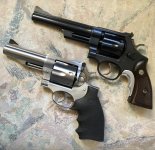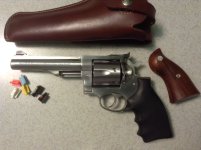I own a couple 2 3/4” Ruger Speed Sixes, one in .357 Mag and another in 9mm Luger, as well as a 2 3/4” Security Six. I also own a 4” Service Six and a 6” Security Six both in .357.
The Speed Six has a round butt and low profile fixed sights and comes primarily in the 2 3/4” length with a few 4” made (although they are probably Speed Six frames used to fill Service Six contracts.
The Service Six/Police Service Six revolvers have the same fixed sight but on a square butt frame and we’re normally made with 4” and 6” barrels.
The Security Six also has a square butt, even on the 2 3/4” version, has adjustable sights and was made in 2 3/4”, 4” and 6” lengths.
Ruger designed them to compete with the S&W Models 13, 19, 65 and 66 and their respective configurations. Ruger used investment casting for the frame and for the fire control parts. The frames lack a side plate and are stronger than a S&W frame, as all the fire control parts load from the bottom. The investment cast fire control parts were conservatively designed and as such as slightLy larger than corresponding S&W parts. They are very strong and broken fire control parts are almost unheard of on the Ruger DA revolvers.
The frame was also designed to be stronger around the forcing cone and the major selling point is that it was designed for a steady diet of .357 Magnum ammo, where the Model 19, etc wasn’t. I’ve seen a few heavily used Security Sixes with very eroded forcing cones but I’ve never seen one crack. A Model 19 or 66 with similar forcing cone erosion would have almost certainly cracked in the thin spot where the forcing cone is relieved for clearance for the crane.
S&W responded to the Ruger Speed/Service/ Security series by coming out with the stronger L frame.
As noted above the triggers on the Rugers feel a bit more mechanical than on comparable S&Ws, and it’s probably due to the use of (more reliable) coil springs and the greater mass of the fire control parts. But the trigger pull is otherwise generally quite good.
Like many people I prefer the look of the S&W revolvers, but to be honest if I had to live on a deserted island with a single revolver and an unlimited supply of .357 Mag ammo, I’d take a Security Six.
——-
The major change with the GP 100 was the addition of a crane lock and the switch to a peg style grip frame. The peg grip allows for a much wider range of adjustment in trigger reach and grip size by swapping grips than is possible with the grip frame design of the K and L grip frame. Unfortunately Ruger also adopted a full under lug and I am not an under lug fan as they just add unnecessary weight and bulk.
The Red Hawk is more or less N frame sized and retains a traditional grip frame. With the standard stocks the trigger reach on a Redhawk is just slightly less than the N frame, but a redesigned Redhawk with a peg grip frame and smaller grip options would sell like hot cakes.
Below are a 2 3/4” Ruger Security Six (top left) and a 2 3/4” Speed Six (bottom left) with (top to bottom on the right) a 2 1/2” Model 66, 3” Model 13, and 3” Model 686+. The Ruger revolvers generally weigh about 2 oz more than a comparable S&W.
Here are a 6” Security Six, a 4” Service Six and a 2 3/4” Speed Six.
You will also find two different styles of recoil shields, the earlier round style and the later scalloped style. I prefer the look of the scalloped style but many Ruger fans prefer the round style.





